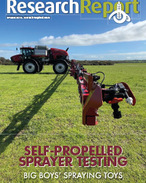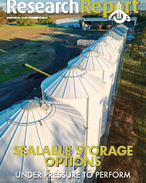In an effort to independently quantify anecdotal evidence, the impact on performance by implementing a range of adjustments to a standard Case IH 7250 harvester were measured.
Kondinin Group engineer, Ben White sat in the cab with farmer Mason Millsteed observing capacity and engine load figures in a wheat crop averaging between 2.5 and 3.5t/ha yield. At the same time, remotecontrolled Bushel-Plus trays were dropped from the harvester to evaluate losses and complete the harvesting effi ciency picture.
Being the smallest power output machine of the Case IH fl agship 250 series, it was determined that engine power was most likely to be the limiting factor for harvesting
capacity.
For this reason, the machine maintained a constant 100 per cent engine loading while
other variables, for example, sieve settings, concave position and rotor components
were changed individually so the impact of these changes could be evaluated.
HARVESTING ENVIRONMENT
It is important to recognise that machine setup and settings may need to be adjusted
to achieve maximum capacity with minimal losses according to the operating
environment.
But while changes in ambient weather and crop conditions may require adjustment
to achieve optimal harvester performance, this trial did demonstrate the importance
of exploring settings and components that match the conditions.
The wheat crop this testing was conducted in averaged just under 3t/ha yield at under 10 per cent moisture. Ambient conditions were warm and dry with ambient temperature ranging from 25 to 29°C and humidity ranging between 40 and
50 per cent.
Harvesting mode was windrowing the chaff fraction but spreading straw and a harvest weed seed control mill was not used.
BALANCING AND ALIGNING
According to Brett Asphar, most harvesters do not have a balanced or aligned rotor from the factory. He explains that as the heart of the harvester, getting this right is essential if peak productivity is to be achieved with the harvester.
Balancing the rotor involves removing all of the rasp bars and individually weighing them before pairing bars up of a similar mass and mounting them to the rotor
opposing each other.
In the same way a car wheel is balanced, shims can be added to fine tune the balance to ensure there is not a heavy side of the rotor.
Rasp bars were found to vary in weight by as much as 30 per cent during testing.
STARTING POINT
The starting point for this experiment was to take the stock Case IH 7250 and see what it could achieve.
Concaves over the separation area were large wire, but the front two were small
wire as would be standard delivery. Predelivery by Boekemans included balancing
and centre-aligning the rotor parallel to the concave cage along its length.
Test 1: As delivered
• Concaves front to rear wire size: small, small, large, large
• Standard (non-spiked) rasp bars
• Rotor speed 1040rpm
• Concave opening 6mm
• Upper sieve 14mm
• Lower sieve 7mm
• Pre-sieve 6mm
• Fan 860rpm
Result: 2.2% losses, 27t/hr with clean sample
CONCAVE SWAP
Maintaining all other settings, the second concave set was swapped out for a large
skip wire (LSW) concave modules, all other settings were maintained.
Test 2: Larger second concaves
• Concaves front to rear wire size: small, large, large, large
• Rotor speed 1040rpm
• Concave opening 6mm
• Upper sieve 14mm
• Lower sieve 7mm
• Pre-sieve 6mm
• Fan 890rpm
Result: 2.3% losses, 36.9t/hr - high levels of white-heads observed
ROTOR SHIFT
With the rotor already balanced and aligned, it was shifted to the right (away from the outload auger side) to increase the pinch point area. All other settings were maintained.
Test 3: Rotor shifted to the right
• Concaves front to rear wire size: small, large, large, large
• Rotor speed 1040rpm
• Concave opening 6mm
• Upper sieve 14mm
• Lower sieve 7mm
• Pre-sieve 6mm
• Fan 890rpm
Result: 4.7% losses, 30.5t/hr very clean sample
WIDER CONCAVE SETTING WITH SHIFTED ROTOR
With the rotor shifted to the right to increase the pinch point area, the concave was
opened up to 10mm. All other settings were maintained.
Test 4: Wider concave with shifted rotor
• Concaves front to rear wire size: small, large, large, large
• Rotor speed 1040rpm
• Concave opening 10mm
• Upper sieve 14mm
• Lower sieve 7mm
• Pre-sieve 10mm
• Fan 890rpm
Result: 4% losses, 39.6t/hr clean sample
SPIKED RASP BARS, SHIFTED ROTOR, MAINTAINED SETTINGS
Standard rasp bars over the separation area were removed and replaced with a balanced set of spiked Case IH rasp bars. The rotor was left in the right-hand shifted position and concave settings were left at 10mm.
Test 5: Spiked rasp bars wtih shifted rotor
• Concaves front to rear wire size: small,
large, large, large
• Rotor speed 1040rpm
• Concave opening 10mm
• Upper sieve 14mm
• Lower sieve 7mm
• Pre-sieve 10mm
• Fan 890rpm
Result: 5.8% losses, 33.4t/hr clean sample
SPIKED RASP BARS, SHIFTED AND SLOWED ROTOR AND OPENED UP
With the high sieve losses observed in the penultimate test, the rotor speed was reduced, concaves and sieves were both opened up for the final test of the day to minimise losses while maintaining capacity.
After losses were measured with the crop trays, loss monitor sensitivity settings were
adjusted to reflect acceptable losses at one per cent.
Test 6: Spiked rasp bars, concaves and sieves opened up
• Concaves front to rear wire size: small, large, large, large
• Rotor speed 950rpm
• Concave opening 14mm
• Upper sieve 16mm
• Lower sieve 10mm
• Pre-sieve 7mm
• Fan 890rpm
Result: 1.1% losses, 35.6t/hr clean sample
FURTHER TESTING
Over the following days using the calibrated loss monitors and with drying crop conditions, the Millsteed family reported capacity at 100 per cent engine load averaging well above 40t/h and peaking at 50t/h with losses at one per cent.
Brett says one of the biggest learnings is just how wide open the concaves can run
in this confi guration, citing examples of an indicated position of 25mm gap or more.
He adds that we only need to achieve a full thresh and a get an acceptable sample,
anything beyond that is wasting power.
But he adds that there is no silver bullet fix. "Improvements can be made by doing small things which compound, the more small things we do, the bigger the mprovement. Remembering performance gain may not all be in the grain tank but also in the fuel tank."
CONCLUSIONS
There is no doubt harvester setup can have a major impact on performance and roductivity as this testing demonstrates. The ultimate aim is for maximum capacity with acceptable losses, usually below one per cent in cereals.
In higher powered (over 350kW or 470hp) harvesters, the limiting factor will likely be increasing losses as harvest productivity increases. For these machines, optimised setup and settings will deliver fuel effi ciency at maximum throughput for the given crop conditions.
For lower powered machines (below 350kW or 470hp), with comparable threshing
and cleaning/separating areas, horsepower is likely the limiting factor for capacity.
The importance of using drop trays to determine losses and calibrate loss sensors was clearly demonstrated. Put simply, visual assessments do not provide the accuracy needed to make informed decisions around machine setup and setting changes.
According to Brett, the proof is in the numbers as observed. Farm consultants tell us that a harvester costs a nominal $500/rotor hour to run regardless of how much grain it pulls in, so the argument for investing some time into extracting maximum capacity with acceptable losses is convincing.
In the context of his role at Seed Terminator, Brett suggests that the capacity impact of a harvest weed seed control mill can be negated with correct setup and fine tuning of the harvester. Decades as a harvester mechanic for a number of brands ensures Brett is well-skilled for the challenge.
Contact:
Brett Asphar
Seed Terminator
0427 213 389
brett@seedterminator.com.au



